LepiMAP has had its BestMonthEver during the lockdown in April. That is amazing. We asked Fanie Rautenbach, the member of the expert panel who does almost all the formal identifications of butterflies to suggest records which he thought were especially interesting.
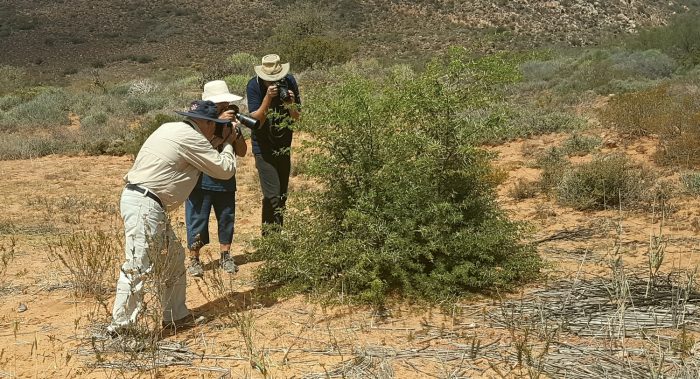
In real life, Fanie is an organic chemist, a researcher at the Cape Peninsula University of Technology. His research area is the chemistry of rooibos tea, especially its health value as an antioxidant. Here’s an article in the Health SA, which you can download, and there is a whole bunch of “full-text available” papers in his profile on Researchgate. It is fascinating. But what we are celebrating now is the contribution Fanie has made to LepiMAP. He has done 88,189 identifications. He is also a big contributor to the Virtual Museum. Here he is on a trip to Robertson, where South Africa’s smallest butterfly, the Dwarf Blue Oraidium barberae was “refreshed” in this grid cell, last seen 142 years previously. We asked Fanie to select a few interesting records of butterflies submitted during Lockdown April.
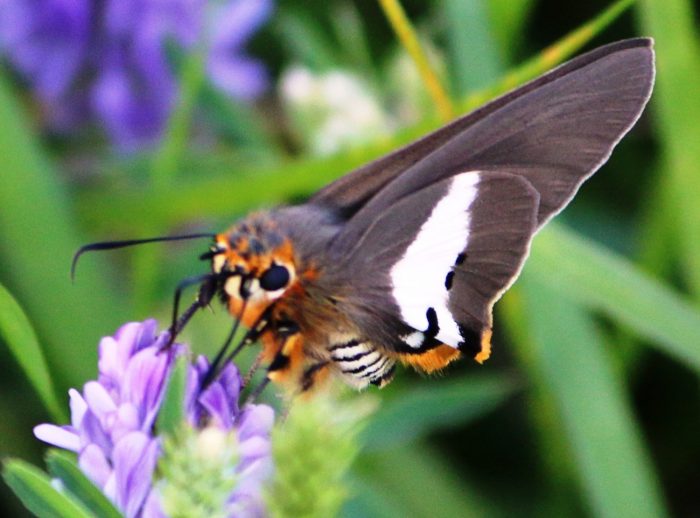
There are 759 records of Two-pip Policeman in the Virtual Museum. So why did Fanie pick out this one? This is a species which has previously been confined, in South Africa, to the northeastern part of the country. It is primarily a savanna species and has a distribution which extends over Africa south of the Sahara Desert. Look at this map.

This map is based on the 539 records, made from the beginning of museum time until 31 December 2013, of the Two-pip Policeman from South Africa, Lesotho and Swaziland. Most of the records are in the northeast. There are two grid cells which stick out as outliers; at Bloemfontein in the Free State and at Kimberley in the northern eastern corner of the Northern Cape. There are seven records, all museum specimens, five from Bloemfontein with dates between 1912 and 1934, and two Kimberley records with no dates. Mmmmmm! Early museum records were often just given the name of the nearest town or city. So let’s disregard all records made in the era of pounds, shillings and pence, and produce a map starting in 1960, and going through to 2013.
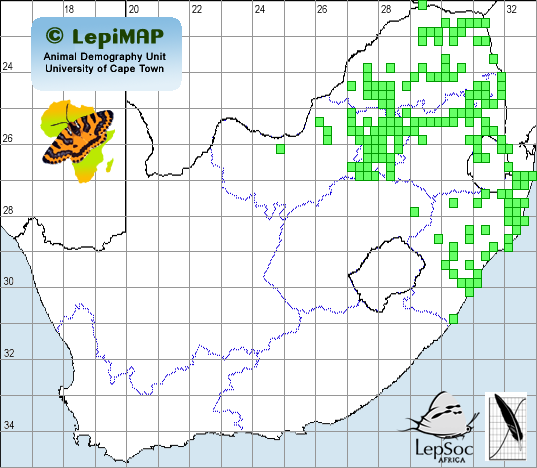
This 1960-2013 map, based on 431 records, looks more plausible than the previous one. The outliers have disappeared, and the “core” of the distribution has remained intact. It makes sense. It’s nice and clean. Now let’s add to this map the 198 records of Two-pipped Policeman made since January 2014. They are added with a blue plus sign. All these records were supported by photographs. Fanie seems to have a photographic memory for distribution maps, and when a record for a species is out of its normal range, he checks that the “nearest town” given by the uploader coincides with the coordinates.

Gosh. The new map seems to resuscitate the problems of the first map. Only it’s worse. There are now four records that really stick out as outliers. But they have all been carefully checked and are genuine. In July 2014, Quartus Grobler made the astonishing discovery of Two-pip Policeman in East London (LepiMAP 549043). Altha Liebenberg has recorded it twice in Danielskuil (May 2016, 598285, and March 2017, 617341). Then, in January this year, Ryan Tippett recorded it just north of Carnarvon, the westernmost record (701775). To rub salt into the wound, Altha spent the lockdown period with family in Kuruman, and found a Two-pip Policeman in the garden on the last Sunday of the month, 26 April (715920).

Can these five records of Two-pip Policeman be dismissed as vagrants, individuals which moved far beyond the “normal” range? Or are they the only detections so far of a westward range expansion? We simply do not know. But we do know that we need a lot more LepiMAPpers on the ground in these sparsely populated parts of South Africa! And it would be really valuable if LepiMAPpers regularly refreshed species, even common species, throughout their ranges.
Thanks, Fanie, for picking a fascinating record to launch this blog.
But why on earth is a butterfly called a policeman? We put this question to Steve Woodhall. “In the old days, policemen patrolled on foot, and they followed a ‘beat’. This was a route through the area they were individually responsible for. They would check on things like houses they knew to be unoccupied, known lurking places for criminals, etc. And once they had completed their beat, they would return to the start and repeat it… again, and again, until their shift was finished. ‘Policeman’ butterflies do a similar thing. They patrol an area, visiting the same spots again and again, following a ‘beat’. Hence the name.” What a well thought through concept, a name based on behaviour. Thanks, Steve.
Fanie’s second choice is this butterfly submitted by Reinier Terblanche from his garden in Potchefstroom in North West Province. It is a Nomad Dart Andronymus neander neander.
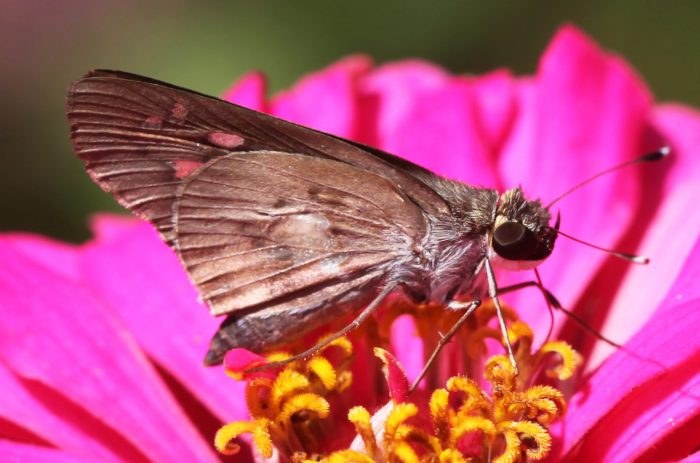
It is the third photographic record of this species in LepiMAP for South Africa. The first was made by Christopher Willis near Thohoyandou in Limpopo in March 2013 (record 28914), and the second was made in Standerton in Mpumalanga in March 2014 (record 45845). There are also photographic records for Zambia, Namibia, Malawi, Tanzania and Mozambique, and together with all the historical data there are a total of 55 records in the LepiMAP database. Here is the distribution map for South Africa, Lesotho and eSwatini.
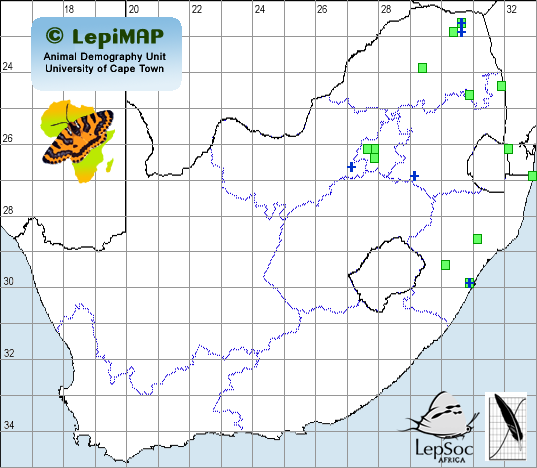
The map shows that Reinier’s record is the first in North West Province. There does not appear to be certainty that the species actually breeds in this region. It breeds further north, from Zimbabwe to East Africa. The lepidopterists describe its status in South Africa as a “migrant”, but ornithologists would probably say “vagrant”. In countries like Tanzania there are records of Nomad Darts heading southwest in millions, just like in northern South Africa we see Pioneer Caper Whites (the new English common name for Brown-veined Whites) Belenois aurota heading northeast in millions. The shot gun pattern of records on this map is similar to the pattern for non-breeding bird species which overshoot their normal migration destinations and are recorded as vagrants in northern South Africa (eg Eurasian Blackcap Sylvia atricapilla, which normally migrates as far as East Africa). It does seem that the Nomad Darts arriving in South Africa are the lucky ones that survive to travel the farthest, and that Reinier’s dart was one of the luckiest of them all.
And Fanie’s third choice is a record of a species which is a bit of a puzzle. Zenobia van Dyk found this Common Evening Brown Melanitis leda in her garden at Bushmanskloof in the Cederberg northeast of Clanwilliam, where she is a senior guide. This is not the anticipated habitat for a species that is associated with leaf litter under trees in deep shade.

Fanie says: “Check out the distribution map for this species. It it usually found in the forest areas of South Africa (KwaZulu-Natal, Mpumalanga, Limpopo). However, every now and again one turns up in an unexpected place like Clanwilliam. Other strange locations are Nieuwoudtville, Komaggas and Kgalagadi Transfrontier Park. I have no explanation for this because it is not a migratory species.” So let’s go and check out the map.
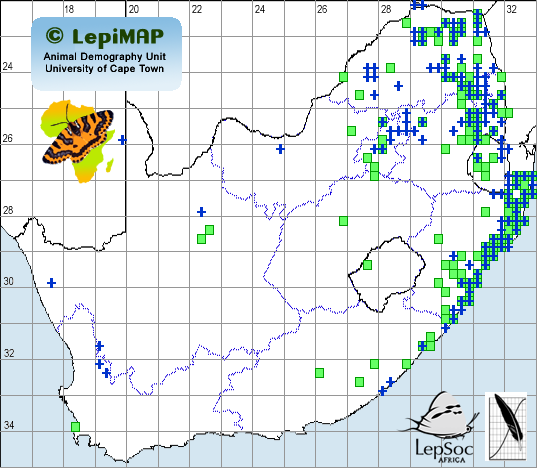
The map shows a well-behaved pattern in the moist areas where forested habitats occur. And then it has a badly-behaved pattern of isolated records, both for the period up to 2006 and for the period from 2007, scattered across the arid western half of this region. The scattered records are even more surprising because this species is a weak flyer. If it is disturbed it makes a short laboured flight before settling.
Reinier Terblanche, of Nomad Dart fame, has been researching butterflies for decades. In 2000, he co-authored a report on the butterflies of the Witsand Nature Reserve, near Posmasburg in the Northern Cape (go to Metamorphosis, and see pages 122-131). This is arid countryside. He and his co-author were astonished to find Common Evening Brown here. They wrote: “It is unlikely that Melanitis leda can be regarded as a migratory species, covering great distances to settle for a limited time at places far from its known distribution. It is more likely that Melanitis leda occurs at places with enough water or shade even in times of drought. Trees with enough shade are probably essential so that the [shade seeking] grasses the larvae feed on are sustained. The occurrence of Melanitis leda in the Witsand area can be indicative of the importance of available water in an area with erratic rainfall.” The Witsand Nature Reserve is an amazing place; there is permanent water, and a couple of hectares of quite thick woodland!
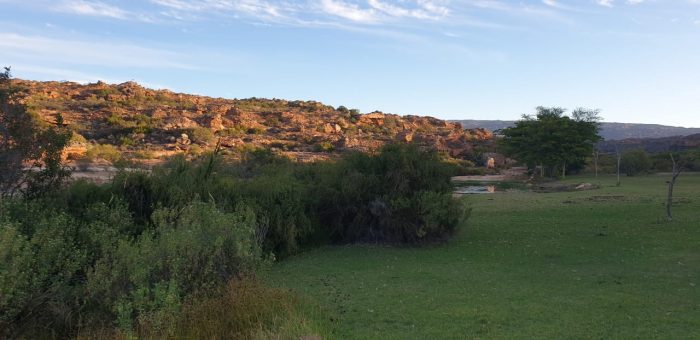
Likewise, at Bushmanskloof, Zenobia reports: “We have a couple of hectares of gardens and have a lot of trees. I found the butterfly late afternoon. It was not flying well, clearly at the end of its life. If you look at the photos the wings are old and broken.” Go to LepiMAP 716380 and look at the other photo uploaded by Zenobia.
The bottom line is that there are lots of butterfly distribution puzzles, and more records in LepiMAP will help solve them. I’ll give the last sentences of this blog to Reinier. In his paper, he was trying to find the words to put the discovery of Common Evening Brown into context. “The occurrence of Melanitis leda at places like Witsand will become much clearer when information on the distributions of Lepidoptera is available in atlas format” and “it is important to pay attention to distribution records of common and widespread species. Such distribution records might be vital keys in our understanding of butterflies as indicators for environmental management.” Thanks, Reinier, that underlines the importance and value of LepiMAP. We need to have BestMonthEver for LepiMAP repeatedly.
Thank you, Fanie Rautenbach, for the choice of records from LockdownApril. Thank you, Steve Woodhall (whose revised fieldguide to the butterflies has just been published) for the explanation of the name of “Policeman”. Thank, Zenobia van Dyk, for the extra photo. Thanks, Altha Liebenberg, for the idea of producing this blog.

